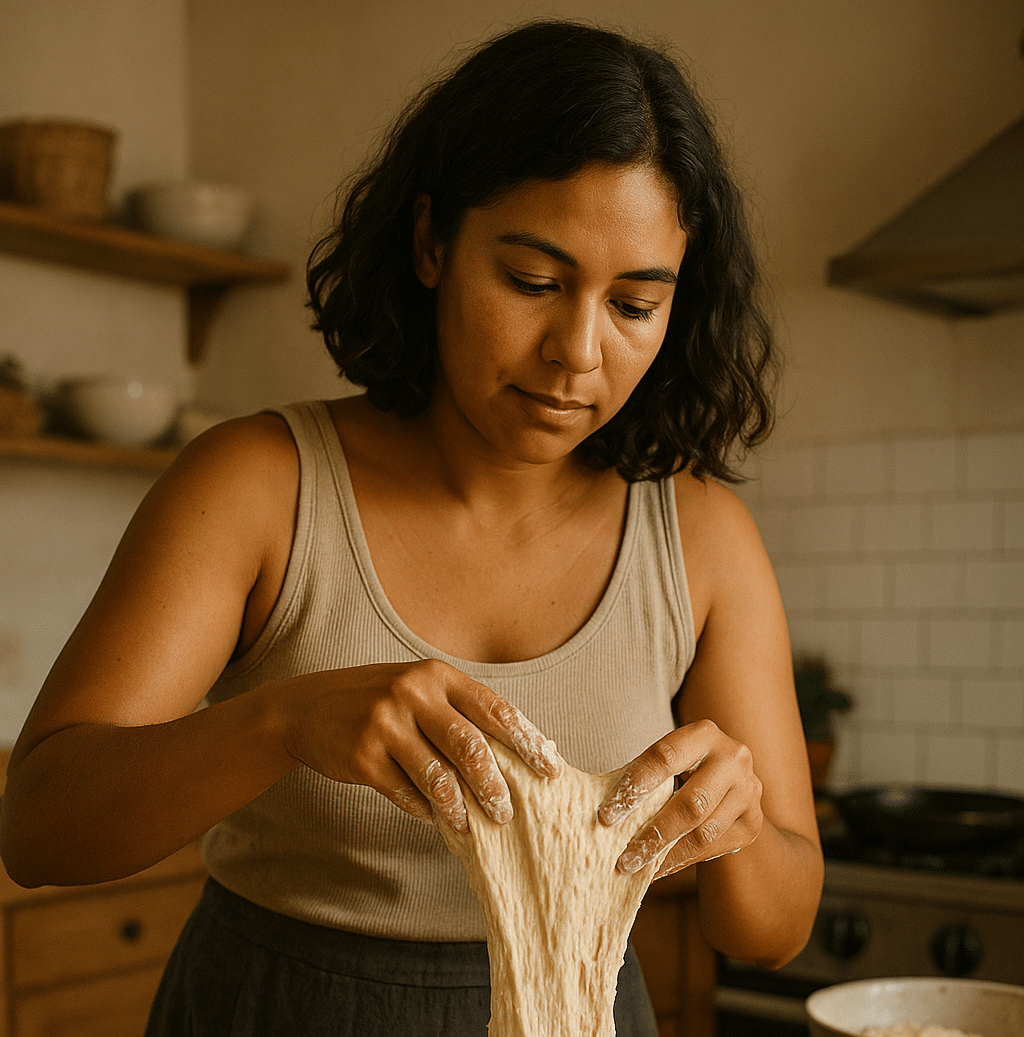Ciabatta is known for its open crumb, chewy crust, and rustic look—but what happens when you marry it with the wild tang of sourdough? In this article, we’ll break down exactly what sourdough ciabatta is, how it compares to other breads, what makes it a standout choice nutritionally, and most importantly—how to bake your own loaf with bold flavor and incredible texture. Whether you’re wondering if ciabatta can be sourdough (yes!), or looking to tweak hydration for the perfect airy interior, this guide will bring you the answers—plus a cozy backstory and helpful tips along the way.
Why Sourdough Bread Ciabatta is Worth the Wait
From Starter to Crust: A Story of Sourdough Discovery
Welcome, kindred baker. I’m Emma, and I believe every loaf has a story—mine began with a jar of flour, water, and a little leap of faith. The first time I tried baking ciabatta with sourdough starter instead of commercial yeast, I was skeptical. Would it still get those big airy holes? Would it stay soft inside and crunchy outside? It took a few attempts (okay, several), but what emerged was magic. That first golden, slipper-shaped loaf gave me a kind of joy I hadn’t expected. It had depth, character, a tangy edge that lingered just enough.
I’ve found that sourdough isn’t just a method—it’s a mindset. Ciabatta, with its high hydration and wild fermentation, teaches patience and instinct. If you’ve ever worried whether your starter was “ready,” or stared at a sticky dough wondering if it was too wet, you’re not alone. That’s part of the joy. My journey into wild yeast baking really began here, with sourdough ciabatta.
What Makes Sourdough Bread Ciabatta Special
The focus keyword, sourdough bread ciabatta, describes more than just a fusion of style and method. It brings together two iconic elements: the high-hydration structure of ciabatta and the living culture of sourdough. Unlike traditional yeast-leavened ciabatta, sourdough versions rise slower and develop complex flavor over time.
What sets it apart:
- Open crumb: thanks to extended fermentation and high hydration (around 80%).
- Bold crust: ciabatta’s crust shines with sourdough’s natural blistering.
- Deep flavor: earthy, mildly tangy, never one-note.
If you’re curious about how hydration plays a role, our tips on open crumb baking and crust perfection might help shape your next loaf. This is a recipe that rewards attention but doesn’t punish experimentation—exactly what sourdough should be.
How Sourdough Changes Ciabatta for the Better
Fermentation for Flavor and Structure
If you’ve only ever tasted ciabatta made with commercial yeast, you might be surprised at how much the sourdough bread ciabatta version differs. That’s because sourdough introduces an entirely different fermentation process—one that relies on wild yeasts and beneficial bacteria instead of a single strain. This slow fermentation creates nuanced flavors: nutty, slightly tangy, and full of depth.
One major advantage is that the dough becomes more digestible. The long ferment helps break down gluten and phytic acid, which can make sourdough ciabatta easier on the stomach. Not only does it taste better, it can actually feel better to eat.
From a technical standpoint, sourdough fermentation also helps strengthen the gluten network without over-mixing. That’s essential when you’re aiming for those classic ciabatta characteristics: an open, holey crumb and a chewy texture with real integrity.
For more on fermentation timelines and dough handling, I share some detailed tips over on the starter care and feeding guide. It’s amazing what a thriving culture can do for a “simple” loaf.
Mastering the Shape: Slippers and Air Pockets
Ciabatta means “slipper” in Italian, and it earns the name with its loose, wet dough that spreads into a flat, rustic shape. When you make sourdough bread ciabatta, you’re working with a hydration level of 75%–85%, which can feel challenging at first. The key is resisting the urge to add too much flour. You want sticky, not stiff.
Shaping sourdough ciabatta is all about gentle hands and timing. After bulk fermentation and a series of stretches and folds, the dough is divided and shaped directly onto a well-floured surface. There’s no tight balling or banneton resting—just a quick flip and proof before baking.
One trick I’ve learned: don’t skip the bench rest. That short pause before final shaping helps relax the dough and makes handling a little easier. If you’ve read our piece on shaping open crumb breads, you’ll recognize how these little decisions add up to airy interiors and crisp crusts.
The final bake transforms that delicate dough into a golden, hollow-sounding loaf with a crust that crackles and a center that’s perfect for olive oil dipping, sandwiches, or simply tearing into.
Is Sourdough Ciabatta Healthier Than Regular Bread?
Sourdough vs. Commercial Bread: A Gut-Friendly Winner
When people ask, “Is sourdough bread healthier bread?”—the short answer is yes, and the long answer is even more compelling. Especially when it comes to sourdough bread ciabatta, which combines the slow-fermented benefits of sourdough with the light texture of an artisan-style Italian loaf.
Let’s start with digestibility. Unlike typical white bread, sourdough undergoes a lactic acid fermentation process. This breaks down phytic acid, which means your body can absorb more of the minerals in the flour—think magnesium, iron, and zinc. That’s one reason many people report fewer digestive issues with sourdough than with conventional loaves.
Then there’s the glycemic impact. Studies suggest that sourdough bread may cause a slower rise in blood sugar compared to yeast-leavened versions. That’s especially relevant if you’re managing your energy levels or avoiding blood sugar spikes. Ciabatta is already lower in sugar and fat than enriched breads, and sourdough takes it a step further.
If you’re interested in more sourdough health tips, the starter guide for beginners has a whole section on gut health and nutritional benefits. And yes, you can enjoy carbs with confidence.
Why Ciabatta Holds a Health Edge Too
Is ciabatta bread healthier than regular sandwich bread? That depends on what you’re comparing. Traditional ciabatta is made with flour, water, salt, and yeast—no oils, no sweeteners, and no preservatives. The texture is airy and filling without being heavy. When made with sourdough starter, it gets even better.
Sourdough bread ciabatta delivers that pillowy crumb without the additives. It stays fresh longer, thanks to the natural acidity created during fermentation, which acts as a mild preservative. That means fewer chemicals and longer shelf life—naturally.
Another edge? Ciabatta’s light interior means you’re getting more air and less density per slice, which can reduce overall calorie intake per serving, especially when compared to dense rolls or enriched loaves.
Over on our bread basics page, we’ve touched on this: sometimes the best bread isn’t packed with ingredients—it’s about how it’s made. Sourdough + simplicity is a combination your gut and taste buds will thank you for.
How to Make the Perfect Sourdough Bread Ciabatta at Home
Ingredients and Timing: Keep It Simple, Let It Work
Making sourdough bread ciabatta isn’t about perfection—it’s about rhythm. It starts with simple ingredients:
- 500g bread flour
- 400g water (80% hydration)
- 100g active sourdough starter (20%)
- 10g salt
The process stretches over 24 hours, but most of that is hands-off. Here’s the breakdown:
- Mix: Combine flour and water, autolyse for 1 hour.
- Add starter and salt: Mix until incorporated.
- Stretch and fold: Every 30 minutes for 2 hours.
- Bulk ferment: 4–6 hours until dough is bubbly and risen.
- Cold ferment: Refrigerate overnight for flavor and strength.
This extended fermentation is where sourdough shines. During this slow rise, your dough develops structure and flavor while preserving the airy nature of ciabatta. You’ll notice the dough feeling alive—and that’s a good sign.
Need guidance on feeding your starter the day before? Our starter maintenance tips can help ensure yours is strong and ready.
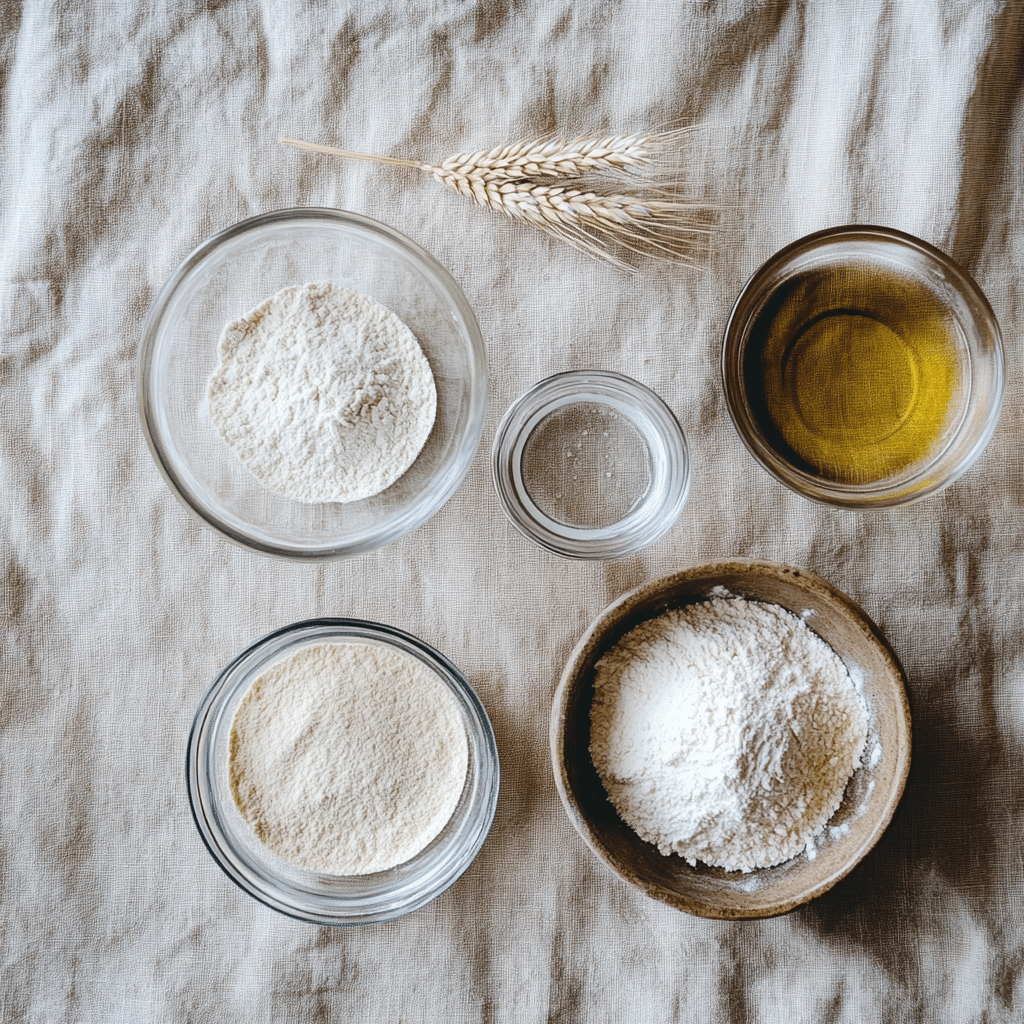
Shaping, Proofing, and Baking: Embrace the Slack
After the cold ferment, turn your dough onto a heavily floured surface. Divide it gently—no kneading, no tension-building. Ciabatta’s loose structure is part of its charm. Let the pieces rest for 30 minutes.
Preheat your oven to 475°F (245°C) with a baking stone or steel, plus a tray for steam. Transfer the dough to parchment, mist with water, and slide onto the hot surface. Add hot water to the steam tray and close the door quickly.
Bake for 20–25 minutes, or until the crust is deep golden and crackles when touched. Cool completely before slicing (trust me—it’s worth the wait).
For tips on perfect crust texture, see our hydration and baking technique guide, which walks through methods for rustic loaves like this.
Once you’ve nailed your first sourdough bread ciabatta, you’ll never look at store-bought the same way again.
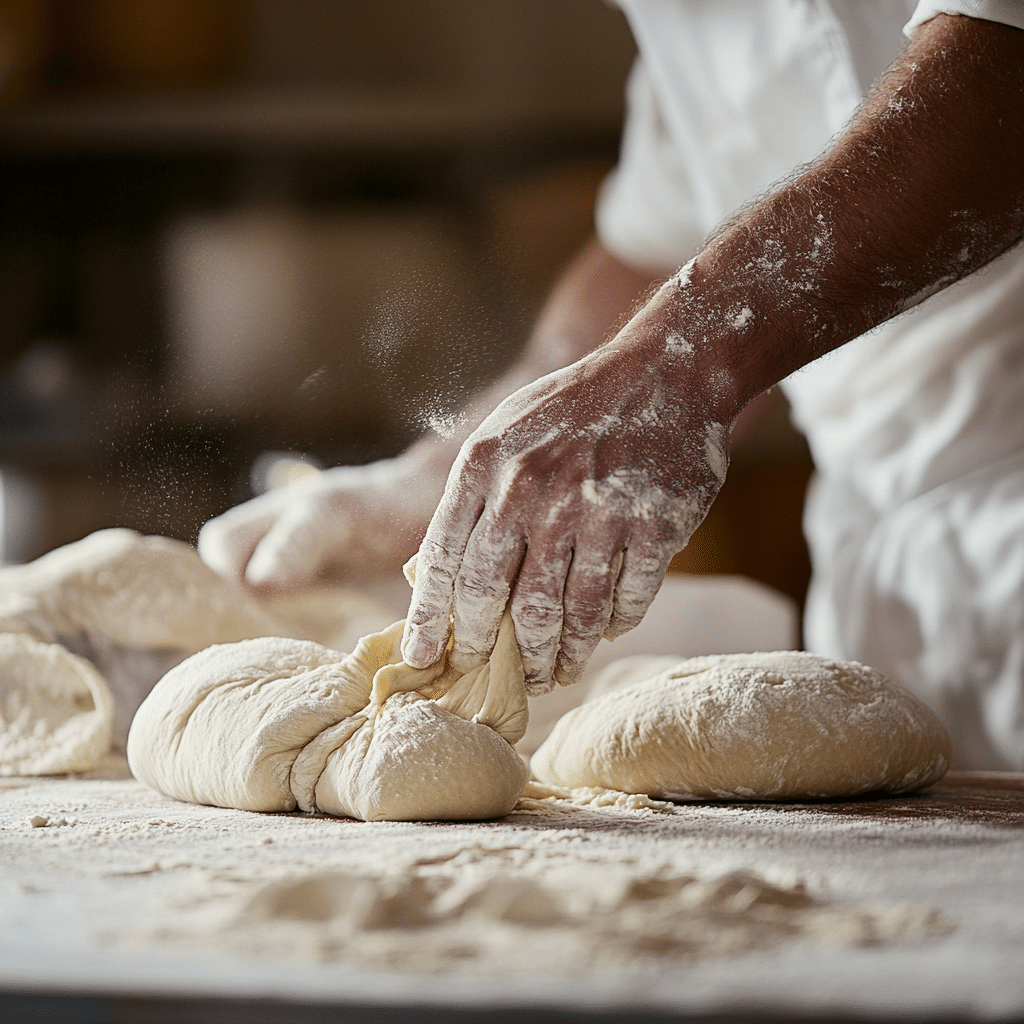
FAQs: Your Sourdough Ciabatta Questions Answered
Is ciabatta a sourdough bread?
Traditional ciabatta isn’t sourdough—it’s usually made with commercial yeast. But it can absolutely be made as a sourdough, which gives it better flavor and digestibility.
What makes ciabatta different from bread?
Ciabatta stands out for its open crumb, high hydration, and chewy texture. It’s often flatter and slipper-shaped with a crisp crust and soft, holey interior.
Is ciabatta bread healthier?
Compared to processed sandwich loaves, ciabatta is often lower in sugar, fat, and additives. When made with sourdough, it also becomes more digestible.
Is sourdough bread healthier bread?
Yes—sourdough fermentation breaks down gluten and phytic acid, helps with mineral absorption, and supports gut health. It also tends to cause smaller blood sugar spikes than commercial yeast bread.
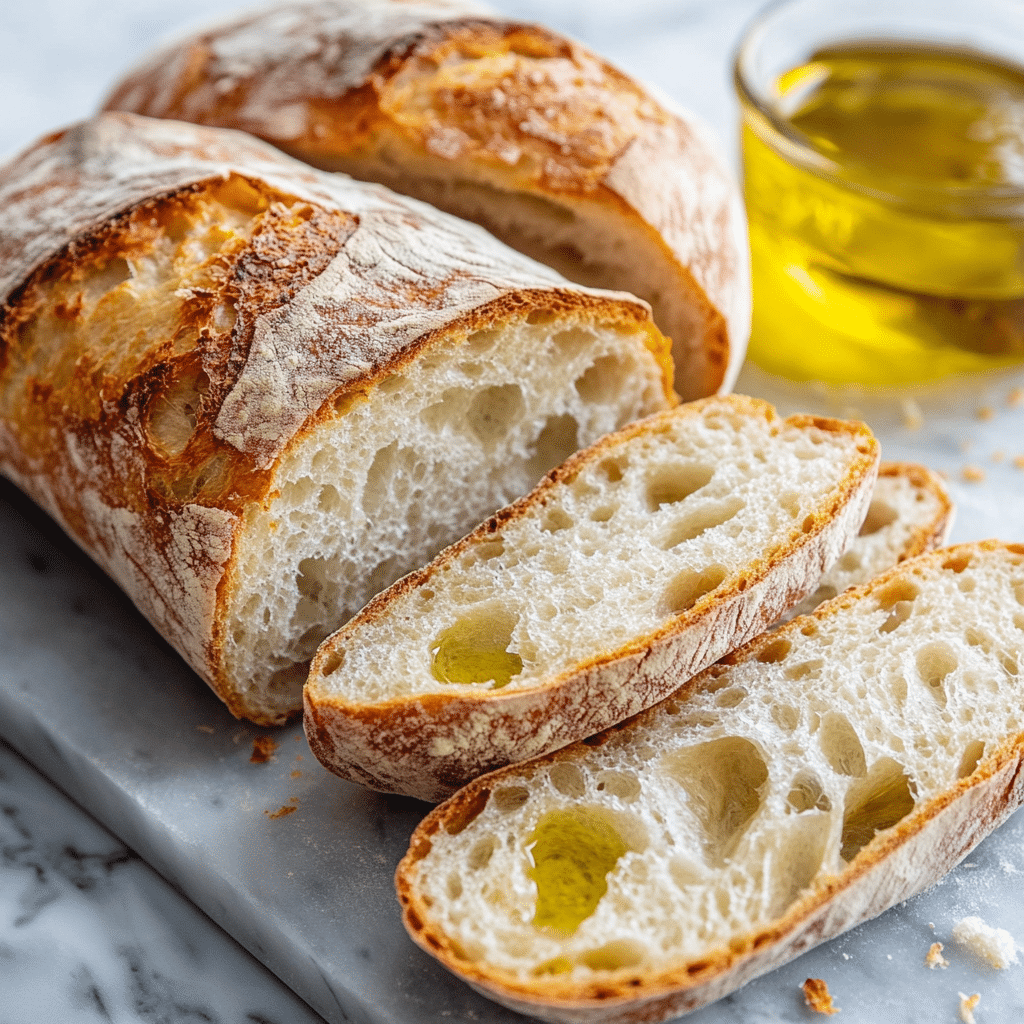
Conclusion
Sourdough bread ciabatta is the perfect blend of tradition and fermentation magic. It rewards patience with an airy crumb, chewy crust, and nourishing flavor that’s hard to beat. Whether you’re new to sourdough or looking for a fresh take on a classic loaf, ciabatta is your next baking adventure. And if you’re still unsure where to start, our guides on starter care and dough shaping are always here to help
Print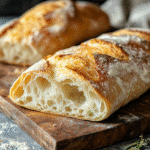
Sourdough Bread Ciabatta: Crisp, Airy, and Totally Worth It
- Total Time: 18 hours 25 minutes
- Yield: 2 medium loaves
- Diet: Vegetarian
Description
Rustic sourdough ciabatta with golden crust, open crumb, and bold tangy flavor.
Ingredients
500g bread flour
400g water
100g active sourdough starter
10g salt
Instructions
1. Mix flour and water. Let autolyse for 1 hour.
2. Add starter and salt. Mix until fully combined.
3. Perform 4 sets of stretch and folds, every 30 mins.
4. Let bulk ferment for 4–6 hours until doubled.
5. Cold ferment overnight in fridge.
6. Shape gently into loaves on floured surface.
7. Proof 30 minutes while oven preheats to 475°F.
8. Bake 20–25 minutes with steam. Cool fully.
Notes
High hydration dough can be sticky—don’t add extra flour.
Use parchment to transfer to oven.
Crumb opens best when dough is handled gently.
- Prep Time: 18 hours
- Cook Time: 25 minutes
- Category: Bread
- Method: Baking
- Cuisine: Italian


